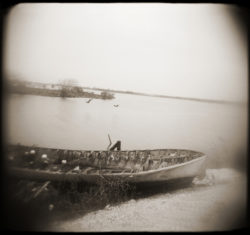George Yerger and Leslie Addison
New Orleans-based George Havard Yerger and Leslie Addison are a husband and wife team of photographers.

Courtesy of George Yerger and Leslie Addison
Boat and Pelicans, Delacroix. Yerger, George (Photographer)
The New Orleans-based husband and wife team George Havard Yerger and Leslie Addison have spent years traveling the back roads of Louisiana and Mississippi in search of those iconic remnants of a decaying and changing rural South that have inspired generations of writers and visual artists. Yerger and Addison have a deep reverence for and connection to the land that lies along both sides of the Mississippi River. Both have deep family roots in Louisiana and Mississippi. Yerger was born in Vicksburg, Mississippi, on March 23, 1941, and Addison in Baton Rouge, Louisiana, on April 17, 1951. Yerger’s ancestors were cotton planters in the Delta region of northeast Louisiana and northwest Mississippi. His great-grandfather was in General Grant’s army that occupied northeast Louisiana and Vicksburg during the Civil War. Addison’s family, which once ran an inn on the Old Natchez Trace, has lived near Port Gibson, Mississippi, for almost two centuries.
Addison studied art at the Institute of Art in San Miguel De Allende, Mexico. She cites photographers Anselm Kiefer, Walker Evans, Clarence John Laughlin, Hieronymus Bosch, and Cy Twombly as influences, along with artists from the post-World War II Abstract Expressionism movement. Yerger, influenced by Robert Frank, Sigmar Polke, Mike and Doug Starn, Walker Evans, Paul Strand, and Anselm Kiefer, has a BA degree from Southeastern Louisiana University in Hammond.
Since 2000, the two have completed three remarkable series of photographs of rural Louisiana and Mississippi — Firefly Diaries: Memories and Dreams of a River Country (2001-02), Phantom Winds: A Mystic Hymn of Louisiana (2004-05), and Field Notes: Searching for Southern Mythology (2001-10). Their work is imbued by childhood memories of growing up along the Mississippi River in rural Louisiana and Mississippi and by writers who wove gothic tales of these singular landscapes and the real and mythic people who inhabit them. Addison and Yerger describe their images as “offhand moments and everyday iconography that is the essence of our culturally rich and immensely layered southern existence. The words of William Alexander Percy, Willie Morris and William Faulkner echo in our minds.”
After completing Firefly Diaries, Addison claims she discovered what Eudora Welty had written earlier in Some Notes on River Country: “I have never seen, in this small section of old Mississippi River country … anything so mundane as ghosts, but I have felt many times there a sense of place as powerful as if it were visible and walking and could touch me.” The two sense that same touch. “I can’t tell you how much we feel that,” Addison once said in an interview. “I have [family] buried all over that area in little overgrown, forgotten cemeteries and old homesteads. That feeling is as strong for George in the Louisiana and Mississippi Delta as for me in the Claiborne County and Port Gibson area of Mississippi. We both get these feelings when we wander around the whole area between Vicksburg and Natchez on both sides of the River.”
Other passages in Welty’s stories resonated with Addison as well. “It’s not just her mentions of familiar places,” continues Addison. “It’s her soulful understanding of the more ethereal qualities of the area.”
In the Phantom series, Addison and Yerger concentrated solely on photographing coastal Louisiana. The images are accompanied by passages from nineteenth-century writer Lafcadio Hearn’s novels and short stories set in Louisiana. “We started this project on Christmas Day 2004,” they wrote in a statement accompanying the photographs. “Unbelievably, it snowed. The grayness of the light was the perfect beginning. Our intention for this work was to portray South Louisiana as we felt it, a layered landscape of mystery and shadows. These photographs have a moody poetic feel that describe the complex beauty and sensuality of these areas and our love for them. The work is not meant to be a literal record but rather a look into a subliminal, internal, living, breathing land.” They completed the project two weeks before Hurricane Katrina hit. “Some of the excerpts we used from Hearn’s writings seem almost prophetic now.”
At times, their photographs are straightforward, almost documentary responses to what they saw. Others are more complex and intuitive layered images, much like old memories coming together. They often call to mind the work of the late surrealist photographer Clarence John Laughlin, who gained national fame for his 1948 book, Ghosts along the Mississippi.
Yerger creates these manipulated images by photographing scenes with inexpensive, plastic disposable cameras. In the Phantom series, he used this type exclusively. “The nature of the plastic lens, light leaks and vignettes of the edges lent our pictures a moody lack of clarity that accentuated the mystery of these places. Sometimes we used multiple exposures to reveal the chaotic and confusing layers of memory and create overlapping time sequences. The camera encouraged us to work intuitively without the normal preoccupation of technical issues.”
The couple has also been passionately involved in photographic expeditions to South and Central America. This work has taken them to Peru, Bolivia, Honduras, Mexico, Panama, Guatemala, and Nicaragua.
Addison and Yerger’s awards include a fellowship from the Pollock/Krasner Foundation, the Louisiana State Division of the Arts Artist Fellowship, two grants from the Louisiana Cultural Economy Foundation, and a grant from the Contemporary Art Museum of Houston. Their work is included in the permanent collections of the Museum of Fine Arts, Houston; the Mississippi Museum of Art, Jackson, Mississippi; Ogden Museum of Southern Art, New Orleans; the Louisiana Arts and Science Museum, Baton Rouge; the High Museum of Art, Atlanta; and the New Orleans Museum of Art.
